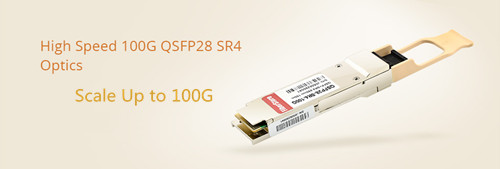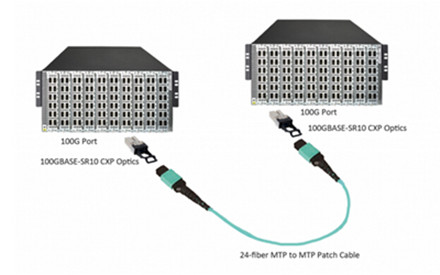Stay For 40Gbps Network or Scale Up to 100G?
petak , 12.08.2016.The evolution of bandwidth for data transmission is unstoppable. From the 10Mbps, 100Mbps Ethernet to the 10G or 40/100G Ethernet, telecom manufacturers keep promoting higher internet speed to facilitate people’s daily life. Now, bandwidth speeds of 1Gbps to 10Gbps Ethernet capacity are commonly utilized around the world. However, with the increase in data center and cloud computing technologies, the demand for bandwidth speeds of 40G to 100G Ethernet is growing steadily for carriers and other data consumers.
Just like the dilemma of whether to use the fiber optic cable for high performance or adopt copper cable for the low cost, these high-end data consumers also have the doubt about 40G and 100G. Should we upgrade our capacity to 40Gbps or skip 40Gbpsand migrate directly to 100Gbps Ethernet? This article will help to draw an answer to this dilemma from the aspects of market trend for required bandwidth, cost and performance.
Upgrade Straight to 100G
According to today’s market trend, the tendency is to skip 40Gbps. With demanding users peeling off multiple 10Gbps channels, the 40Gbps pipe becomes quickly utilized. Carriers scaling up to 100Gbps, allows greater flexibility for one’s network infrastructure utilizing multiplexing solutions to carve multiple bandwidth channels from a single pipe. On another scale, the same is true for the consumer market where capacity is increasing from 1Gbps to 10Gbps, skipping 2.5Gbps levels, due to the flexibility and scalability 10Gbps provides at a very similar cost. In many cases, carriers and consumers have decided to skip 40Gbps and acquire 100Gbps for the following reasons and benefits:

- Cost Efficiency—From a network equipment standpoint, often it may be more cost-efficient to upgrade a 10Gbps link to 100Gbps, versus 40Gbps. Essentially, if you should require 60Gbps or say even 80Gbps, additional cards would be needed to support the link in the chassis, whereas a customer may utilize only one card to achieve more than twice the bandwidth at 100Gbps. 100Gbps allows the network to operate within a smaller footprint of a data center, which in turn, reduces power consumption dissipating less heat and thus lower operational costs.
- Lower Latency—100Gbps provides lower latency capabilities than 40Gbps; many carrier grade vendors are lowering latency on 100Gbps matching latency of traditional 10Gbps traffic.
- Flexibility—Creates options to provide multiple variations of delivery with handoffs ranging from 10Gbps, 40Gbps or the full 100Gbps pipes.
- Scalability—Although a customer may not utilize 100Gbps on day one, the ability is there to scale the network with no forklift upgrade at any point, future-proofing the solution well beyond capacity needs.
As consumer’s demands for higher bandwidth continues to rise, many equipment suppliers, who developed some of the first 100 Gigabit Ethernet Router Interfaces, are now working on developing 200Gbps, 400Gbps up to 1 Terabyte interfaces.
This article is not implying that there is no use for 40Gbqs bandwidth level technology. Instead, I suggest that many end consumers are looking to keep up with the acceleration of high bandwidth demands while maintaining the efficiency and technologies needed to support their network infrastructure requirements while reducing operating costs.
100G Optic Solutions
FS.COM 100G transceiver solution offers customers 100 Gigabit Ethernet connectivity options for data center networking, enterprise core aggregation, and service provider transport applications. Various of 100G transceivers including CXP, CFP, CFP2, CFP4 and QSFP28 are available for different applications. The following part will lists two cost-effective 100G solutions.
- QSFP28 to QSFP28 Interconnection
The QSFP28 is the exact same footprint as the 40G QSFP+, but is implemented with four 25Gbps lanes. To interconnect a multimode QSFP28 link, a 12-fiber MPO/MTP patch cable is required, while for single-mode link (100GBASE-LR4 QSFP28), a duplex LC single-mode patch cable is required. The interconnection of QSFP28 multimode link is similar with the case of QSFP28-100G-SR4 see in the following figure.

- CXP/CFP to CXP/CFP Interconnection
FS.COM’s 24-fiber MPO/MTP assemblies are ideal for 100GBASE-SR10 CXP/CFP to CXP/CFP interconnection in data center, since it is implemented 10 lanes of 10 Gbps. Among the 24 fibers, only 20 fibers in the middle of the connector are used to transmit and receive at 10 Gbps and the 2 top and bottom fibers on the left and right are unused. The following picture shows the interconnection between two 100GBASE-SR10 CXP ports.

FS.COM provides a full selection of 100G optics including CFP, CFP2, CFP4, QSFP28 (QSFP28-100G-SR4) and QSFP28 DAC cables just as listed above. All of our products are fully compatible with the original brand. In addition, our 100G transceivers offer significant advantages over existing solutions in terms of reduced power dissipation and increased density with the added benefit of pluggability for reduced first installed cost. If you have any requirement, you can send your request to us.
Oznake: 100GBASE-LR4 QSFP28
komentiraj (0) * ispiši * #
Why Choose QSFP28 Transceivers for 100G Transmission?
srijeda , 18.05.2016.Over the years, there has been an unprecedented increase in network connectivity and bandwidth needed to accommodate workload requirements of cloud computing, and high-performance web services. The rapid advancements in fiber optic technology has enabled easy upgrading from 10GbE to 40/100GbE within the data centers. With the emergence of 100GbE technologies, the creation of data center network architectures free from bandwidth constraints has been made possible. Among 100G interconnect components, QSFP28 transceiver is the predominant form factor for 100G switching and routing connectivity, a key enabler as 100G begins to ramp in data centers.
QSFP28 Brief Introduction
QSFP28 is the exact same footprint as the 40G QSFP+ module, “Q” for “Quad”. Just as the 40G QSFP+ is implemented using four 10-Gbps lanes, the 100G QSFP28 is implemented with four 25-Gbps lanes. In all QSFP versions, both the electrical lanes and the optical lanes operate at the same speed, eliminating the costly gearbox found in CFP, CFP2, and the CPAK. The QSFP28 module has an upgraded electrical interface to support signaling up to 28Gbps signals, yet keeps all of the physical dimensions of its predecessor. As QSFP28 technology becomes even maturer, QSFP28 transceivers become more and more popular in 100G optics market.
There are mainly two 100G QSFP28 transceiver versions: 100GBASE-SR4 QSFP28 transceiver and 100GBASE-LR4 QSFP28 transceiver. The former is specified to operate over multi-mode fiber (MMF) with the maximum link length of 70m on OM3 and 100m on OM4, while QSFP28 100GBASE-LR4 is standardized to work through single-mode fiber (SMF), able to realize 10km link length. The image below shows the working principles of 100GBASE-SR4 QSFP28 (left) and 100GBASE-LR4 QSFP28(right).
Why Choose QSFP28 Transceiver?
Since its surge, the QSFP28 transceiver has gained increasing popularity among enterprises or organizations, as it increases density and decreases power and price per bit. 100G QSFP28 makes it as easy to deploy 100G networks as 10G networks. Listed below are specific reasons why choose QSFP28 for 100G transmission?
At the first point, QSFP28 increases front-panel density by 250% over QSFP+. Although QSFP28 has the same form factor and the maximum number of ports as QSFP+ module, the lane speeds are increased from 10Gbps to 25Gbps.
Next, QSFP28 breaks some limitations found in other 100G optics. For instance, in the first generation of 100G switches and routers, the smaller CXP form factor was used for cabling and the CFP or CFP2 was used for transceivers. This forced the equipment designer to make huge sacrifices. Besides, a switch with CXP port could not be used in any data center with SMF, and a router with CFP2 or CPAK ports was limited in bandwidth by the 8-10 ports that could fit on the front panel. Well, as for QSFP28, it’s designed to support both cables and transceivers. Within QSFP28, a 1 rack-unit (RU) switch can accommodate up to 36 QSFP ports on the front face plate. Many varieties of either transceivers or cables can plug into these ports. The cables can be either direct attach cables (DACs), commonly referred to as direct attach copper cables, or active optical cables (AOCs).
Finally, QSFP28 transceivers can use either VCSELs (for shorter distances on MMF) or silicon photonics (for longer distances on SMF). The advent of silicon photonics enables QSFP28 transceivers to support any data center reach up to 2km or more. Silicon photonics provides a high degree of integration; the CMOS chips are small enough to fit within a QSFP package. Silicon photonics is low-power; even WDM designs can fit within the 3.5W maximum of QSFP.
Conclusion
With the fiber optic technology becoming maturer and more available, the choice of high-bandwidth switches, routers, and adapters which feature QSFP28 will be diversified, ensuring data centers to scale to 100G networks with the simplicity as 10G networks. Fiberstore supplies a large number of QSFP28 transceivers available in QSFP28 100GBASE-SR4 and QSFP28 100GBASE-LR4 types. If you want to know more information about QSFP28 transceivers, you can visit Fiberstore.
Oznake: 100G, QSFP28, QSFP+ module, 100GBASE-SR4 QSFP28, 100GBASE-LR4 QSFP28, QSFP28-100G-LR4
komentiraj (0) * ispiši * #


